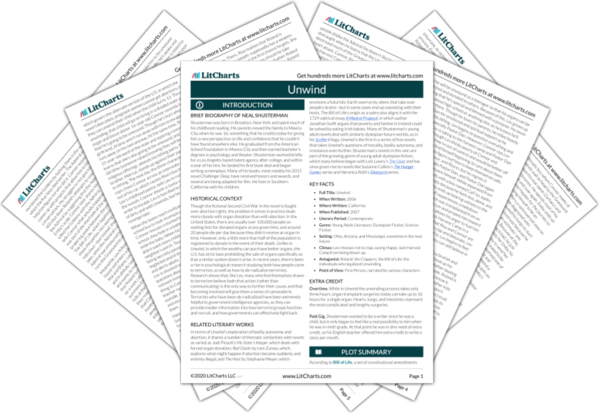Inequality, Injustice, and the Law
Unwind introduces the reader to a futuristic version of the United States. In the relatively recent past of the novel, the U.S. resolved the debate and subsequent Heartland War over abortion by adopting the Bill of Life, which states that after conception, a parent cannot terminate an unwanted pregnancy—but they can, once their child turns 13, begin to unwind the child. Unwinding is a process by which teenagers between the ages of 13 and…
read analysis of Inequality, Injustice, and the LawAnger, Violence, and Radicalization
Every child slated to be unwound has every right to be angry—deciding to unwind one’s child suggests, to kids like Connor who grew up in loving families, that their parents don’t love or care about them anymore, while for kids like Risa who grow up as wards of the state, being unwound reflects the government’s unwillingness to value the lives they’re supposed to care for. In this sense, anger is a natural state in which…
read analysis of Anger, Violence, and RadicalizationActivism, Compassion, and Atonement
Once Connor and Risa find themselves in the hands of sympathetic adults who want to save them from being unwound, the novel begins to pay close attention to the avenues available to individuals who wish to push back against the system and fight for a better future. Specifically, though it does illustrate that turning to terrorism, as Lev does, is one available path, it shows clearly that activism and resistance that are rooted in…
read analysis of Activism, Compassion, and Atonement
Morality and Perspective
In the world of Unwind, many seem to think that they live in a utopia. Any injury, disorder, or illness is curable, since science and medicine are advanced enough to simply replace the ill or defective body part with a brand-new, healthy one—and those with the money and inclination can “upgrade” body parts simply because they want to for aesthetic reasons. To many people in society, this is a perfectly moral and just system…
read analysis of Morality and Perspective






